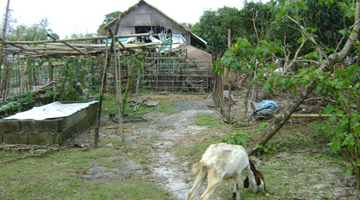 The recent onslaught of typhoons Pedring and Quiel damaged the farms of Magsasaka Siyentistas (MS) Eustaquio Teves in Mariveles, Bataan and Oscar Sebastian in San Felipe, Zambales.
The recent onslaught of typhoons Pedring and Quiel damaged the farms of Magsasaka Siyentistas (MS) Eustaquio Teves in Mariveles, Bataan and Oscar Sebastian in San Felipe, Zambales.
Teves and Sebastian are cooperators of the Philippine Council for Agriculture, Aquatic and Natural Resources Research and Development’s (PCAARRD) Science and Technology-based Farm (STBF) projects on slaughter goat production.
A visit to the farms of these MSs revealed that floods due to heavy rains drowned 30 of Sebastian’s goats and ruined his goat houses, pushing him to terminate the STBF project. He explains that it would be costly to start the project again.
In contrast, the two typhoons did not affect the STBF projects in Nueva Ecija and Nueva Vizcaya. The goats, goat houses, and pasture areas/forage gardens of MS Cornelio Pambid and Salvador Laluan both from Nueva Ecija and MS Reonel Agaran of Abian, Nueva Vizcaya appeared undamaged.
The assessment visit was conducted from October 10 to 23 by staff members of PCAARRD in coordination with the partner member agencies of the Central Luzon Agriculture and Resources Research and Development Consortium for the Bataan, Zambales, and Nueva Ecija leg; and Cagayan Valley Agriculture and Resources Research and Development Consortium for Nueva Vizcaya.
The team was pleased to observe the goats’ good health condition and well-managed STBF projects in Nueva Ecija and Nueva Vizcaya. Some recommendations were put forward to carry on with sustainable goat production performance. These include the provision of visible stock records per pen which indicate the number of does, kids, pregnant does, and expected date of kidding; gathering of information on birth weight, weaning weight, market, and number of days to attain market weight.
Moreover, seeds of leguminous trees like ipil-ipil and kakawate can be collected and propagated to sustain the production of fodder legumes. The trees can serve as fence for rotational grazing or as hedge rows for cut-and-carry feeding system.
